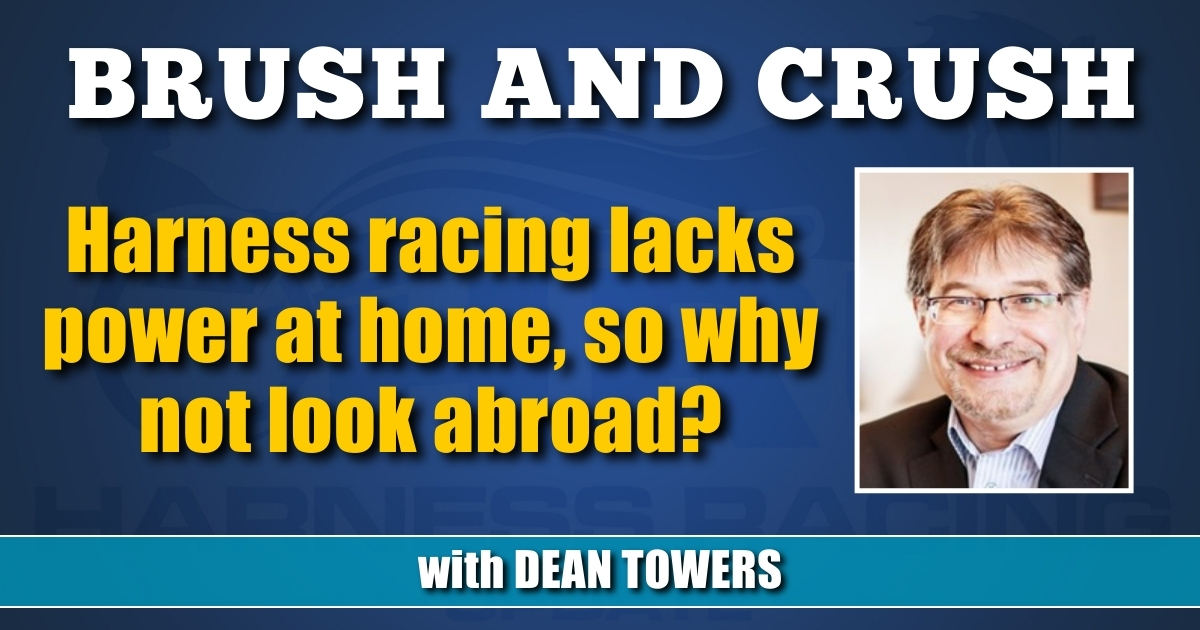Harness racing lacks power at home, so why not look abroad?
While the big dogs in thoroughbred racing flex their muscles, North American harness racing drops further down the wagering food chain.
by Dean Towers
Over in thoroughbred land, the incomparable Saratoga meet began in earnest on Thursday (July 11). This year, though, initially, there was a hitch. On July 4th the New York Racing Association announced that they were eliminating all content from FanDuel (TVG) wagering platforms because of a contract impasse. That impasse was resolved before the meet began on Thursday, but had it not been resolved it would have meant people with a FanDuel account would not have been able to bet the meet.
As usual, the fight was about money.
NYRA’s Saratoga signal is popular, and when you’re popular, you have pull, even if against you lies FanDuel, the largest betting entity in North America. What NYRA wants, FanDuel is unwilling to pay.
In other sports this would probably be confusing. The National Football League wouldn’t withhold their games from NBC, the Super Bowl from CBS, or Monday Night Football from ESPN, even if they weren’t contractually obliged. These networks are partners, and they help the whole NFL ecosystem go. In horse racing however, this is fairly common.
My question: If a thoroughbred racing entity can wave goodbye to the largest betting platform on the continent what does that say about harness racing’s place on the totem pole?
It probably says — despite the sport asking for mostly meager signal fees from large racing fiefdoms — it’s the lowest of the low. When this sport is down that far and is that irrelevant it has absolutely no power; it’s at the mercy of everyone else’s whims.
In my view, when any business is in that position, growth is not only difficult, it’s probably impossible.
Fortunately, the sport does not revolve around FanDuel and NYRA; Los Angeles or New York or Miami.
I read Joe Faraldo’s Director’s Chair in Hoof Beats last fall. In the piece, Faraldo argued that harness racing’s place in the landscape lies beyond this continent’s borders, and detailed some of his work in expanding the sport to faraway places. Some might remember the commingled pools in the International Trot as one piece of evidence of that. The handles were formidable.
As I perused this latest signal fight, and thought about it more and more, I believe Faraldo is onto something.
If our best harness signals and races could be packaged, scheduled and made workable for export, it opens up brand new markets. These markets could not only increase handle, but allow for less of a reliance on large thoroughbred betting entities; groups that seem to have little use for our sport (and pay a pittance to host its races).
This is obviously a complex and difficult ask. Leaving aside the problems related to different betting platforms and international laws, horsepeople are not going to be trucking horses for Lasix at six in the morning to meet an obscure post time. Our evening cards have to be protected for a myriad of reasons. There are unassailable rules to live by.
But to me there has to be more to this sport than being an afterthought of the North American betting entities; there has to be more than having a world class harness stakes race double-boxed on TVG with a five claimer from Charles Town; there has to be more than being happy with Kentucky Sires Stakes money, or a New Jersey subsidy, or a slot machine.
There’s a whole world out there, and maybe this sport should begin to explore what it has to offer.

















